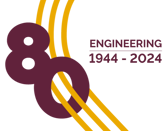
[Article by Nane Zietsman]
Ms Marisa du Plessis’s engineering journey started with a bang – literally. “I had a reputation in my residence for fixing electronics and causing mini explosions in my room. I can’t say that our Residence Head was happy with my endeavours, but it ultimately encouraged me to take a leap of faith and change my course from BSc to Engineering in my second year,” says Ms Du Plessis. According to Ms Du Plessis, her shift to engineering was greatly based on the prospects the degree offers: “The knowledge you obtain in the course can be applied to a variety of activities. Knowing that I can make a difference in the field of my choice because I’m not bound to one singular industry, kept me motivated.”
Showcasing the potential of her engineering knowledge, Ms Du Plessis completed her BEng final year project in the Electrical and Electronic (E&E) Engineering Department despite being a Mechatronic Engineering student. “The arrangement to do my final year project in the E&E Department happened when I pitched my topic. I reached out to my current supervisor, Dr Rensu Theart, to ask for advice with regards to which lecturer he thinks would be a good fit. He responded by asking if he could be a part of the project by being my supervisor and I accepted immediately,” shares Ms Du Plessis. Unknowingly, Ms Du Plessis’s topic involved a problem that Dr Theart was similarly aware of: “My wife is an occupational therapist and the problem Ms Du Plessis aimed to address is one that she has often come across in her line of work. I was therefore quick to get involved because I knew how valuable a solution to this matter would be.”
Ms Du Plessis’s BEng final year project aimed to prevent the initial development pressure ulcers, specifically within permanent wheelchair users. This objective was met through the design, build and validation of a targeted, varying pressure control system implemented within a wheelchair cushion. “I became aware of pressure ulcers and the discomfort they cause through a close family member who is bound to a wheelchair. I started to think of a way to prevent the forming of pressure ulcers and it led me to my topic,” says Ms Du Plessis.
The system she ultimately designed utilises real-time feedback control to vary the pressure in the cushion automatically based on current and historical pressure measurements across its surface. These measurements are relayed to a web interface to display live and historical measurements. “The final design is a pneumatic wheelchair seat, comprising of an array of air cells containing pressure sensors for closed-loop pressure control. The localised pressure in high-pressure regions can thus be reduced, allowing for unobstructed blood flow in the section of the skin above the deflated air cell,” explains Ms Du Plessis.
“It was pleasing to see Ms Du Plessis’s genuine passion and interest in her topic. This meant that she had inherent motivation to make the project a success and my role was purely to encourage the process,” says Dr Theart. He and Ms Du Plessis are currently in the process of expanding and commercialising the wheelchair cushioning system. Apart from achieving her desired project outcome and the prospects of potentially changing the lives of many individuals, Ms Du Plessis will also join CubeSpace as a junior aerospace engineer next year; ending off her studies just as she began – with a bang.
Photograph: (from left to right) Ms Marisa du Plessis, final design assembly, dashboard channel pressure distribution surface plot.




